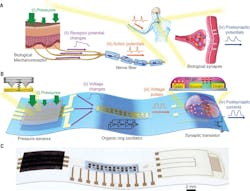Artificial Nervous Systems Brings Real-Life Touch to Robots
Prosthetics limbs have seen several advancements in recent years. With the increased availability of sensors and the ease of 3D printing, several new ventures and research projects have surfaced to design and construct more advanced prosthetics. One of the latest developments is from the joint research venture of Stanford University and Seoul National University, which have been developing an artificial sensory nerve system for prosthetics. This work is the first step toward creating artificial skin that can restore sensation to amputees and potentially give robots reflex capability.
According to Zhenan Bao, a professor of chemical engineering and one of the senior authors on the project, “We take skin for granted, but it’s a complex sensing, signaling, and decision-making system. This artificial sensory nervous system is a step toward making skin-like sensory neural networks for all sorts of applications.”
The new research paper published in Science describes how the team constructed artificial sensory nerve circuitry that could be embedded in the skin-like covering for neuroprosthetic devices and soft robotics. The milestone of the research has been achieving the ability to mimic how skin can stretch, repair, and act like a smart sensory network that can transmit sensations to the brain and order the muscles reflex for decision-making movements.
The nervous circuit is integrated into three components. The first is a touch sensor that detects minuscule forces. It sends signals via the second component, a flexible electronic neuron. The third component is an artificial synaptic transistor modeled after human synapses. The signals from the sensor and the neuron are used to stimulate the transistor. The transistor was designed by Tae-Woo Lee of Seoul National University. “Biological synapses can relay signals, and also store information to make simple decisions,” says Lee, who was a second senior author on the paper. “The synaptic transistor performs these functions in the artificial nerve circuit.”
The image above lays out the different methods of how sensors work in biology and mechanically. The first row, A, shows how a natural, biological afferent nerve is stimulated by pressure. The second row, B, displays an artificial afferent nerve made of pressure sensors, an organic ring oscillator, and a synaptic transistor. Lastly, row C shows the system developed by the research team. It is a photograph of the artificial afferent nerve system that can be used in prosthetic and robot skin.
Lee uses a knee reflex example of how the future advancements of artificial nerve circuits can eventually be used as an artificial skin for prosthetics devices and robots. In a human knee, a sudden tap causes the knee muscles to stretch and activate particular muscle sensors that send impulses through a neuron. The neuron sends signals to synapses, which in turn recognize the pattern of the sudden stretch and emits two signals to the knee. One signal is to contract reflexively the knee muscles and the second is a signal to register the sensation in the brain.
In the Science paper, the research team describes how the electronic neuron delivered signals to the synaptic transistor. The transistor can learn to recognize and react to sensory inputs based on the intensity and frequency of low-power signals, just like a biological synapse.
The team tested the ability of the sensory system by hooking up its artificial nerve to a cockroach leg and applying tiny increments of pressure to the touch sensor. The electronic neuron converted the sensor signal into digital signals and relayed them through the synaptic transistor. This caused the leg to twitch as the pressure on the touch sensor increased or decreased.
The team was also able to show that the artificial nerve could detect various touch sensations with enough accuracy to differentiate Braille letters. In another, it rolled a cylinder over the sensor in different directions and accurately detected the direction of the motion.
The new work has a long way to go before it reaches full maturity. The group hopes to create a low-power sensor net to cover robots to make them more agile via human-like feedback. However, the artificial skin covering prosthetic devices will require new devices to detect heat and other sensations, along with the ability to embed them into flexible circuits and a viable brain interface.


